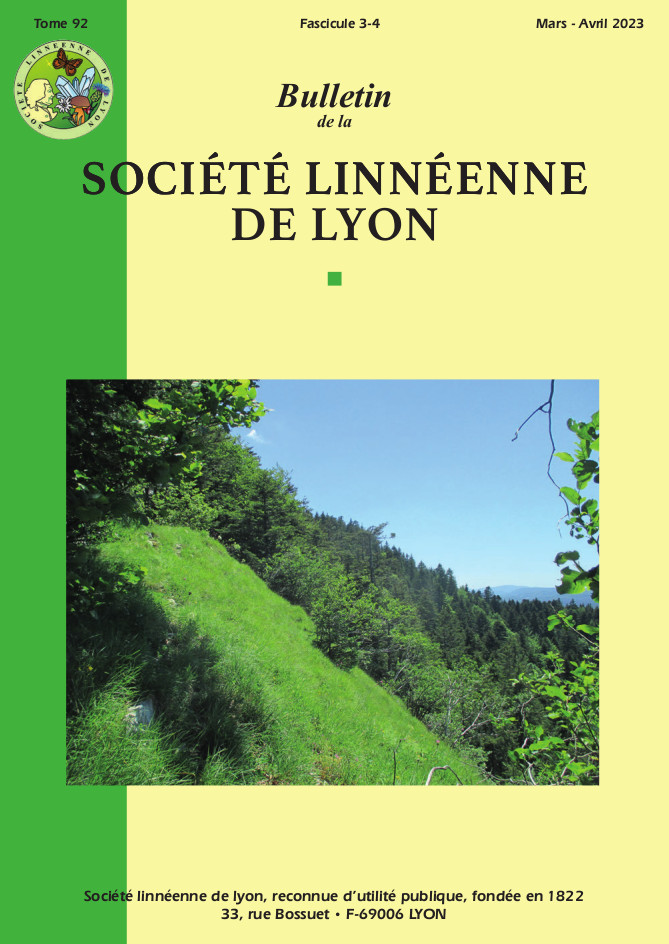Bulletin de la Société linnéenne de Lyon, 2023, tome 92, fascicule 3-4
par
popularité : 5%
Bulletin de la Société linnéenne de Lyon, 2023, tome 92, fascicule 3-4
 Couverture : Corniche de la Roche Samuel (1125 m), à l’ouest de Brénod, Haut-Bugey.
Couverture : Corniche de la Roche Samuel (1125 m), à l’ouest de Brénod, Haut-Bugey.
Crédit : Marc Philippe

AUDIBERT Cédric
Sur la présence d’araignées et d’insectes méridionaux en Drôme des Collines (France) ...... 62-66
On the presence of southern spiders and insects in Drôme des Collines (France)
PHILIPPE Marc et LEGLAND Thomas
Nouveautés cryptogamiques pour le Haut-Bugey (Ain, France) ...... 67-76
Résumé. – Fascinés par les massifs les plus élevés, les botanistes ont relativement négligé les altitudes moyennes. Le massif du Haut-Bugey, culminant à 1500 m, est ainsi relativement méconnu, notamment pour ce qui est de sa flore cryptogamique. Ici sont rapportées de nouvelles observations d’hépatiques (Moerckia flotoviana), de mousses (Drepanocladus lycopodioides, D. sendtneri, Hookeria lucens, Orthotrichum scanicum, Tortella pseudofragilis, T. fasciculata), de lycophytes (Huperzia selago, Spinulum annotinum) et de fougères (Dryopteris villarii, Polystichum × bickenellii) qui démontrent pourtant son intérêt biogéographique. De brèves discussions de ces nouvelles données espèrent encourager les recherches dans cette région.
Mots-clés. – Monilophytes, bryophytes, hépatiques, mousses, fougères, Jura, floristique.
Cryptogamic novelties for the Haut-Bugey (Ain, France)
Abstract. – Fascinated by the highest massifs, botanists have relatively neglected the middle altitudes. The Haut-Bugey massif, culminating at 1500 m, is thus relatively unknown, especially as regards its cryptogamic flora. Here we report new observations of liverworts (Moerckia flotoviana), mosses (Drepanocladus lycopodioides, D. sendtneri, Hookeria lucens, Orthotrichum scanicum, Tortella pseudofragilis, T. fasciculata), lycophytes (Huperzia selago, Spinulum annotinum) and ferns (Dryopteris villarii, Polystichum × bickenellii), which demonstrate its biogeographic interest. Brief discussions of these new data will hopefully encourage further research in this region.
Key-words. – Monilophytes, bryophytes, liverworts, mosses, ferns, Jura, floristic.
GONZALES David
Les Adelina Dejean, 1835 de Guyane française (Coleoptera, Tenebrionidae, Diaperinae, Diaperini, Adelinina) ...... 77-88
Résumé. – Les espèces du genre Adelina Dejean, 1835 de la faune de Guyane française sont présentées. Deux espèces nouvelles sont décrites : Adelina brulei n. sp. et Adelina labriquei n. sp. Avec Adelina frontalis (Champion, 1886), Adelina plana (Fabricius, 1801) et Adelina subcornuta (Ardoin, 1977), ce sont donc cinq espèces qui sont maintenant connues de Guyane française. L’ensemble de ces espèces est illustré et une clé dichotomique est proposée.
Mots-clés. – Tenebrionidae, Guyane française, région néotropicale, Adelina, description, taxonomie, nouvelles espèces.
The Adelina Dejean, 1835 of French Guiana (Coleoptera, Tenebrionidae, Diaperinae, Diaperini, Adelinina)
Abstract. – The species of the genus Adelina Dejean, 1835 of the French Guiana fauna are presented. Two new species are described : Adelina brulei n. sp. and Adelina labriquei n. sp. With Adelina frontalis (Champion, 1886), Adelina plana (Fabricius, 1801) et Adelina subcornuta (Ardoin, 1977), five species are now known in French Guiana. All of these species are illustrated and a key is provided.
Key-words. – Tenebrionidae, darkling beetle, French Guiana, neotropical region,Adelina, description, taxonomy, new species.
BANGE Christian et BANGE Renée
La fondation et les débuts du laboratoire maritime de physiologie de Tamaris (Institut Michel Pacha) (Var, France) ...... 89-109
Résumé. – La station maritime de biologie de Tamaris, qui a reçu le nom d’Institut Michel Pacha, dépendait de la faculté des sciences de l’université de Lyon et était une annexe de la chaire de physiologie générale dont le titulaire depuis 1887, Raphaël Dubois, avait découvert le mécanisme de la production de lumière par les êtres vivants (bioluminescence). Le bâtiment de style mauresque fut construit entre 1891 et 1899 sur un terrain donné par Michel Pacha, administrateur général des phares de l’Empire ottoman, résident de Tamaris, avec son aide financière et des subventions de l’université de Lyon, du département du Var, de la ville de la Seyne ainsi que du fondateur, Raphael Dubois. La station biologique était consacrée aux recherches sur la physiologie des animaux marins et elle servit principalement à Dubois qui, jusqu’à son décès en 1929, y poursuivit son œuvre relative à la bioluminescence ainsi qu’à la physiologie appliquée.
Mots clés. – Stations biologiques, physiologie comparative, bioluminescence.
Founding and beginnings of the biological station in Tamaris (Institut Michel Pacha) (Var, France)
Abstract. – The biological station at Tamaris near Toulon, known as Institut Michel Pacha, was an appanage of the Faculty of sciences, University of Lyon. It was attached to the chair of general physiology hold since 1887 by Raphael Dubois, who discovered the mechanism of bioluminescence. It was built as a Moorisch structure between 1891 and 1899 on a ground given by Michel Pacha, general administrator of the Ottoman light house Service and resident of Tamaris, and with his financial help and also with subventions from the University of Lyon, the department of Var, the commune of la Seyne and its founder. The biological station was devoted to physiological research on marine animals, and was mainly used by Dubois until his death in 1929 for his work about bioluminescence in marine Invertebrates and applied physiology.
Key-words. – Biological stations, comparative physiology, bioluminescence.
PHILIPPE Marc
Yves Lemoigne (1933 - 2022) ...... 110-120
Résumé. – Notice biographique d’Yves Lemoigne (1933-2022), professeur de botanique à l’Université Lyon 1 et chercheur en paléobotanique, spécialiste du Paléozoïque.
Yves Lemoigne (1933 - 2022)
Abstract. – Biographical note on Yves Lemoigne (1933-2022), professor of botany at the University of Lyon 1 and researcher in paleobotany, specialist in the Palaeozoic.
La rubrique de la Bibliothèque ...... 120
PARTIE ADMINISTRATIVE
ORDRES DU JOUR POUR MARS-AVRIL 2023 ...... V-VIII
